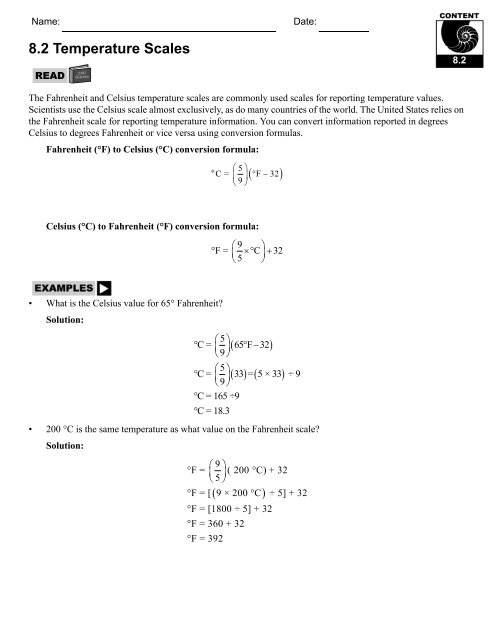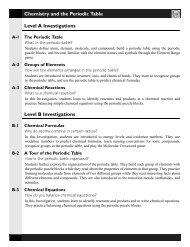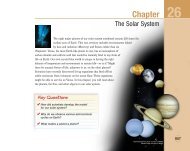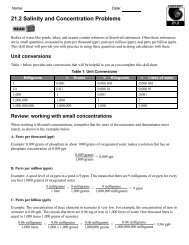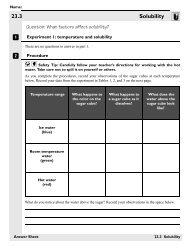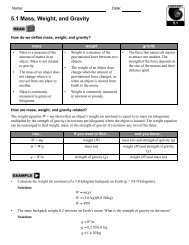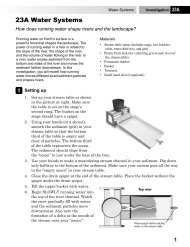8.2 Temperature Scales - CPO Science
8.2 Temperature Scales - CPO Science
8.2 Temperature Scales - CPO Science
Create successful ePaper yourself
Turn your PDF publications into a flip-book with our unique Google optimized e-Paper software.
Name:<br />
Date:<br />
<strong>8.2</strong> <strong>Temperature</strong> <strong>Scales</strong><br />
<strong>8.2</strong><br />
The Fahrenheit and Celsius temperature scales are commonly used scales for reporting temperature values.<br />
Scientists use the Celsius scale almost exclusively, as do many countries of the world. The United States relies on<br />
the Fahrenheit scale for reporting temperature information. You can convert information reported in degrees<br />
Celsius to degrees Fahrenheit or vice versa using conversion formulas.<br />
Fahrenheit (°F) to Celsius (°C) conversion formula:<br />
⎛ ⎞<br />
C = ⎜ ⎟ ° F − 32<br />
⎝9<br />
⎠<br />
o 5<br />
( )<br />
Celsius (°C) to Fahrenheit (°F) conversion formula:<br />
⎛9<br />
⎞<br />
° F = ⎜ ×° C⎟+<br />
32<br />
⎝5<br />
⎠<br />
• What is the Celsius value for 65° Fahrenheit<br />
Solution:<br />
⎛5⎞<br />
° C = ⎜ ⎟( 65° F−32)<br />
⎝9<br />
⎠<br />
⎛5⎞<br />
° C = ⎜ ⎟( 33 ) = ( 5 × 33 ) ÷ 9<br />
⎝9<br />
⎠<br />
° C = 165 ÷9<br />
° C = 18.3<br />
• 200 °C is the same temperature as what value on the Fahrenheit scale<br />
Solution:<br />
⎛9<br />
⎞<br />
° F = ⎜ ⎟( 200 ° C) + 32<br />
⎝5<br />
⎠<br />
° F = [ 9 × 200 °C ÷ 5] + 32<br />
( )<br />
° F = [1800 ÷ 5] + 32<br />
° F = 360 + 32<br />
° F = 392
Page 2 of 4<br />
1. For each of the problems below, show your calculations. Follow<br />
the steps from the examples on the previous page.<br />
a. What is the Celsius value for 212 °F<br />
b. What is the Celsius value for 98.6 °F<br />
c. What is the Celsius value for 40 °F<br />
d. What is the Celsius value for 10 °F<br />
e. What is the Fahrenheit value for 0 °C<br />
f. What is the Fahrenheit value for 25 °C<br />
g. What is the Fahrenheit value for 75 °C<br />
<strong>8.2</strong><br />
2. The weatherman reports that today will reach a high of 45 °F. Your friend from Sweden asks what the<br />
temperature will be in degrees Celsius. What value would you report to your friend<br />
3. Your parents order an oven from England. The temperature dial on the new oven is calibrated in degrees<br />
Celsius. If you need to bake a cake at 350 °F in the new oven, at what temperature should you set the dial<br />
4. A German automobile’s engine temperature gauge reads in Celsius, not Fahrenheit. The engine temperature<br />
should not rise above about 225 °F. What is the corresponding Celsius temperature on this car’s gauge<br />
5. Your grandmother in Ireland sends you her favorite cookie recipe. Her instructions say to bake the cookies at<br />
190 °C. To what Fahrenheit temperature would you set the oven to bake the cookies<br />
6. A scientist wishes to generate a chemical reaction in his laboratory. The temperature values in his laboratory<br />
manual are given in degrees Celsius. However, his lab thermometers are calibrated in degrees Fahrenheit. If<br />
he needs to heat his reactants to 232 °C, what temperature will he need to monitor on his lab thermometers<br />
7. You call a friend in Europe during the winter holidays and say that the temperature in Boston is 15 degrees.<br />
He replies that you must enjoy the warm weather. Explain his comment using your knowledge of the<br />
Fahrenheit and Celsius scales. To help you get started, fill in this table. What is 15 °F on the Celsius scale<br />
What is 15°C on the Fahrenheit scale<br />
°F f °C<br />
15 °F =<br />
= 15°C<br />
8. Challenge questions:<br />
a. A gas has a boiling point of –175 °C. At what Fahrenheit temperature would this gas boil<br />
b. A chemist notices some silvery liquid on the floor in her lab. She wonders if someone accidentally<br />
broke a mercury thermometer, but did not thoroughly clean up the mess. She decides to find out if the<br />
silver stuff is really mercury. From her tests with the substance, she finds out that the melting point for<br />
the liquid is 35°F. A reference book says that the melting point for mercury is –38.87 °C. Is this<br />
substance mercury Explain your answer and show all relevant calculations.
Page 3 of 4<br />
Extension: the Kelvin temperature scale<br />
<strong>8.2</strong><br />
For some scientific applications, a third temperature scale is used: the Kelvin scale. The Kelvin scale is<br />
calibrated so that raising the temperature one degree Kelvin raises it by the same amount as one degree Celsius.<br />
The difference between the scales is that 0 °C is the freezing point of water, while 0 K is much, much colder. On<br />
the Kelvin scale, 0K (degree symbols are not used for Kelvin values) represents absolute zero. Absolute zero is<br />
the temperature when the average kinetic energy of a perfect gas is zero—the molecules display no energy of<br />
motion. Absolute zero is equal to –273 °C, or –459 °F. When scientists are conducting research, they often obtain<br />
or report their temperature values in Celsius, and other scientists must convert these values into Kelvin for their<br />
own use, or vice versa. To convert Celsius values to their Kelvin equivalents, use the formula:<br />
K = °C + 273<br />
Water boils at a temperature of 100 °C. What would be the corresponding temperature for the Kelvin scale<br />
K = °C + 273<br />
K = 100 °C + 273<br />
K = 373<br />
To convert Kelvin values to Celsius, you perform the opposite operation; subtract 273 from the Kelvin value to<br />
find the Celsius equivalent.<br />
A substance has a melting point of 625 K. At what Celsius temperature would this substance melt<br />
°C = K + 273<br />
°C = 625 K −273<br />
°C = 352<br />
Although we rarely need to convert between Kelvin and Fahrenheit, use the following formulas to do so:<br />
⎛9<br />
⎞<br />
°F = ⎜ × K ⎟−460<br />
⎝5<br />
⎠<br />
5<br />
K = (°F + 460)<br />
9
Page 4 of 4<br />
1. Surface temperatures on the planet Mars range from –89 °C to –31 °C. Express this temperature<br />
range in Kelvin.<br />
2. The average surface temperature on Jupiter is about 165K. Express this temperature in degrees Celsius.<br />
3. The average surface temperature on Saturn is 134K. Express this temperature in degrees Celsius.<br />
4. The average surface temperature on the dwarf planet Pluto is 50K. Express this temperature in degrees<br />
Celsius.<br />
5. The Sun has several regions. The apparent surface that we can see from a distance is called the photosphere.<br />
<strong>Temperature</strong>s of the photosphere range from 5,000 °C to 8,000 °C. Express this temperature range in<br />
Kelvin.<br />
6. The chromosphere is a hot layer of plasma just above the photosphere. Chromosphere temperatures can<br />
reach 10,000 °C. Express this temperature in Kelvin.<br />
7. The outermost layer of the Sun’s atmosphere is called the corona. Its temperatures can reach over<br />
1,000,000 °C. Express this temperature in Kelvin.<br />
8. Nuclear fusion takes place in the center, or core, of the Sun. <strong>Temperature</strong>s there can reach 15,000,000 °C.<br />
Express this temperature in Kelvin.<br />
9. Challenge! Surface temperatures on Mercury can reach 660 °F. Express this temperature in Kelvin.<br />
10. Challenge! Surface temperatures on Venus, the hottest planet in our solar system, can reach 755K. Express<br />
this temperature in degrees Fahrenheit.<br />
<strong>8.2</strong>


